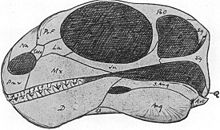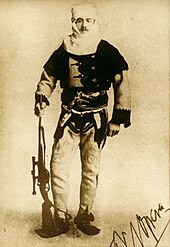Chainosauria
| Chainosauria Temporal range:
| |
|---|---|

| |
| Skull of Galepus, a 'dromasaur' | |

| |
| Skull of Eodicynodon, a dicynodont | |
| Scientific classification | |
| Domain: | Eukaryota |
| Kingdom: | Animalia |
| Phylum: | Chordata |
| Clade: | Synapsida |
| Clade: | Therapsida |
| Suborder: | †Anomodontia |
| Clade: | †Chainosauria Nopsca, 1923 |
| Subtaxa | |
Chainosauria is a large and speciose
Other basal anomodonts, the
Morphology
The majority of chainosaur diversity is found in the dicynodonts, which span a broad range of body sizes but are conservative in form, typically with barrel-shaped bodies, stocky limbs and short tails. By contrast, earlier chainosaurs where much more lightly build and gracile, with elongated and slender limb bones.
Early chainosaurs had also not yet evolved the reduced post-canine dentition, beaks and tusks of dicynodonts, and instead possessed complete rows of teeth lacking differentiated canines (with the potential exception of the anomocephaloid
Internally, the nasopalatine nerve inside the maxilla is already large and well-developed in Patranomodon. This nerve is a branch of the trigeminal nerve, and is associated with the innervation of the keratinous beak in dicynodonts (similar to turtles), and its enlargement in Patranomodon may indicate that greater sensitivity in the premaxilla may have preceded the development of beaks in early chainosaurs.[7]
History of study

Chainosauria was coined by
Nopcsa's concept of Chainosauria to encompass dicynodonts and their close relatives was functionally similar to the modern usage of Anomodontia, which was itself used at the time equivalently to what we recognise as Dicynodontia today. As such, the subsequent redefinition and expansion of Anomodontia by other researchers to encompass dicynodonts and their relatives made Nopcsa's Chainosauria redundant, and so the name fell into disuse for the rest of the 20th century.
This led palaeontologists Christian F. Kammerer and Kenneth D. Angielczyk to resurrect the name in 2009 for this phylogenetic group. They cladistically re-defined Chainosauria as the clade of all anomodonts closer to Dicynodon and Galeops than to Venyukovia, in effect defining Chainosauria to act as a counterpart to the Russian anomodont clade Venyukovioidea. As conceived by Kammerer and Angielczyk, Chainosauria also excluded the basal South African anomodonts Anomocephalus and Patranomodon. However, recent phylogenetic analyses have variably recovered Patranomodon as well as the anomocephaloids as closer to dicynodonts than venyukovioids and thus as chainosaurs by definition.[13][14][15]
Classification
Although intended to be defined as including dicynodonts and 'dromasaurs', the 'dromasaurs' themselves are a

Due to the unstable relationships of basal anomodonts, this has led to varying compositions for Chainosauria. The basal anomodont Patranomodon has been particularly unstable in this regard. It was at first thought to be the basalmost anomodont upon discovery, an interpretation supported by early
The inclusion of both Patranomodon and anomocephaloids in Chainosauria has been described by Angielczyk et al. (2017) as "intuitively pleasing". Both taxa have similar deep and short skull proportions to other chainosaurs, and many of their supposed basal features could alternatively be interpreted as
The relationships of the various 'dromasaurs' are similarly unsettled. Galeops is consistently recognised as the sister taxon of Dicynodontia, but Galepus and Galechirus have been found in varying positions. Initially they were recovered as closely related to Galeops and dicynodonts, such as by Kammerer et al. (2011), and sometimes forming a clade together (Galechiridae).[12] However, in later analyses Galechirus tended to fall outside of Chainosauria altogether in a polytomy with it and Venyukovioidea (such as in the left cladogram below). Furthermore, in a more recent 2017 analysis with an expanded Chainosauria, Galechirus returned to a position close to Galeops, while Galepus was instead found as the most basal chainosaur.[16]
Examples of these varying relationships are shown in the two cladograms below:
Cisneros et al. (2015): Restricted Chainosauria[5]
Angielczyk and Kammerer (2017): Expanded Chainosauria[16]
Biogeography
The composition of Chainosauria has implications for the origins, evolutionary history and biogeography of early anomodonts. An early biogeographic split amongst basal anomodonts has been proposed by researchers between Chainosauria and Venyukovioidea, with Chainosauria radiating in Gondwana in the southern hemisphere and venyukovioids as a Laurasian radiation in the northern hemisphere.[13] Patranamodon and Anomocephalus, having each been considered the most basal anomodont at times, have been used to argue a Gondwanan origin for both chainosaurs and venyukovioids.[4][17] The recognition of the Chinese taxon Biseridens as the basal-most known anomodont alternatively supports a Laurasian origin of anomodonts, from where chainosaurs would have migrated out of and only later radiated in Gondwana.[13]
References
- ISBN 9783110275902.
- ^ a b c Brinkman, D. (1981). "The structure and relationships of the dromasaurs (Reptila: Therapsida)". Breviora. 465: 1–34.
- ^ .
- ^ .
- ^ PMID 26587266.
- .
- S2CID 3428692.
- ^ Nopcsa, F. (1923). "Die Familien der Reptilien". Fortschritte der Geologie und Palaeontologie. 2: 1–210.
- ^ Spindler, F. (2016). "Morphological description and taxonomic status of Palaeohatteria and Pantelosaurus (Synapsida: Sphenacodontia)". Freiberger Forschungshefte. C550 (23): 1–57.
- ^ .
- doi:10.1086/623061.
- ^ .
- ^ PMID 19640887.
- S2CID 129846697.
- S2CID 8178585.
- ^ .
- PMC 1689688.
